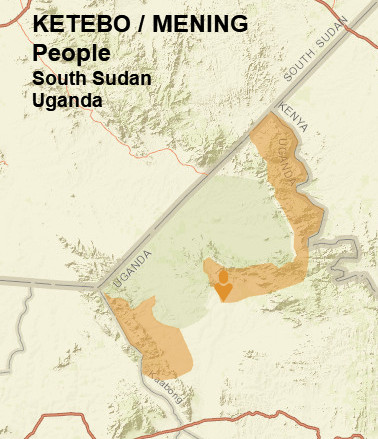

The Ketebo people are an ethnic group in South Sudan. The Ketebo are inhabitants of Bira which is the land of the Ketebo. Bira which was a Ugandan Protectorate until 1925 and was transferred to Sudan’s administration in 1926. The Ketebo are sometimes referred to by the Didinga as "Loceha/Loceka". The Ketebo live in Bira, which is one of the Payams of Kidepo County, Torit, Eastern Equatoria State of South Sudan. They are one of the smallest and least known tribes in South Sudan. The Mening are a tribe in North-eastern Uganda on Uganda's borders with Kenya and South Sudan. The Ketebo in Uganda are called Mening, which is also one of the smallest tribes in Uganda. The population of this ethnic group is over 45,000. Bira is the land of the Ketebo which include; Lofus, Madial, Lorum, Lotome, Lojilingare, Arata, Nakoringole, Lonyili, Kamulach, Tulel, Ofi, Natedo, Nahitahapel (Ihapelmoru), Naurkori, Lochorangichokio, Lokudul, Napeyase, Ogeng, Tongoborei, Kalabe (Apoka), Irobi, Narus, Koryang, Tomoodo, Koryang, Losigiria, Irobi just to mention a few. The Ketebo people are also found in Lotukei in Budi County. |
 |
Ketebo clans |
|||
|
|
|
|
The Ketebo speak Oketeboi and Lokathan languages. The predominant language they speak today is Oketeboi with some mixture of Dongotono. The Mening language is called "Ngamening".
In Uganda, the Ketebo or Mening lived in the area of what is now Kidepo Valley National Park since 1800, but it was gazetted as a game reserve by the British colonial government in 1958. The purpose was both to protect the animals from hunting and to prevent further clearing of bush for tsetse fly-control. After the eviction of the resident people and the resultant famine, the Ketebo people were forcefully relocated to other areas within Bira such as Napotpot, Kalo Kudo, Namosingo, Loriwo and Naurkori in South Sudan. This is cited in contemporary park management as an example of the unacceptable consequences of not taking community needs into account when designating reserves.
The Ketebo people were previously pastoralist in nature but due to change in climate and external influence from the neighbouring communities they are now practicing cultivation systems, with sorghum, maize and sesame as the main crops during the growing season (April to August).
The Mening are agricultural people. They farm sorghum, millet, maize, beans, and other vegetables. Their staple food is Sorghum and Maize. Sorghum is called "Ngamam" and Maize is called "Locheri". Sorghum or Maize flour is used to make bread. A drink called "Mere", is made from sorghum and maize. However, they were previously hunters. Their relocation from the game reserve caused them to adopt agriculture.
Bira is isolated and inaccessible. The nearest health centers are in Ikotos, 117 kilometres (73 mi) away, and Karenga in Uganda 65 kilometres (40 mi) away
The Mening dress code is a Maasai shuka and beads jewelry. Men dress in a Maasai shuka either tied diagonally from their shoulder, or in form of a skirt. Women dress in a Maasai shuka skirt with a beads belt. Women wear a series of bangles, necklaces, bracelets and headbands.
made out of
The Mening, together with the Napore, Dodoth, Jie, IK, and Karimojong are the guardians and custodians of the areas neighboring the east, western, and southern boundaries of Kidepo Valley National Park. These areas are home to beautiful mountain ranges that include Mount Morungole on the east, on Uganda's border with Kenya, Loyilli hills and mountains on the west, and the beautiful semi-arid plateaus in the south. The regions east of Kidepo Valley National Park are also home to Karenga Community Wildlife Management Area, a 956 sq km wildlife conservation area popular for the East Sudanian Savannah Biome. Karenga Community Wildlife Management Area is home to a number of wildlife including; leopards, lions, elephants, buffaloes, giraffes, and birds.
The hills, valleys, mountains, and plateaus in the areas east, west, and south of Kidepo Valley National Park offer picturesque views including views of Uganda's Tripartite point with Kenya and South Sudan and the East African rift valley. These areas are also perfect for camping and hiking.
The Mening are Uganda's 2nd smallest tribe (after the Mvuba tribe). The smallest are the Vonoma tribe.
There are 2,655 Mening (2014 census) in Uganda. The Mening are mainly found in Kaabong, Karenga, and Kotido districts.
Sources: